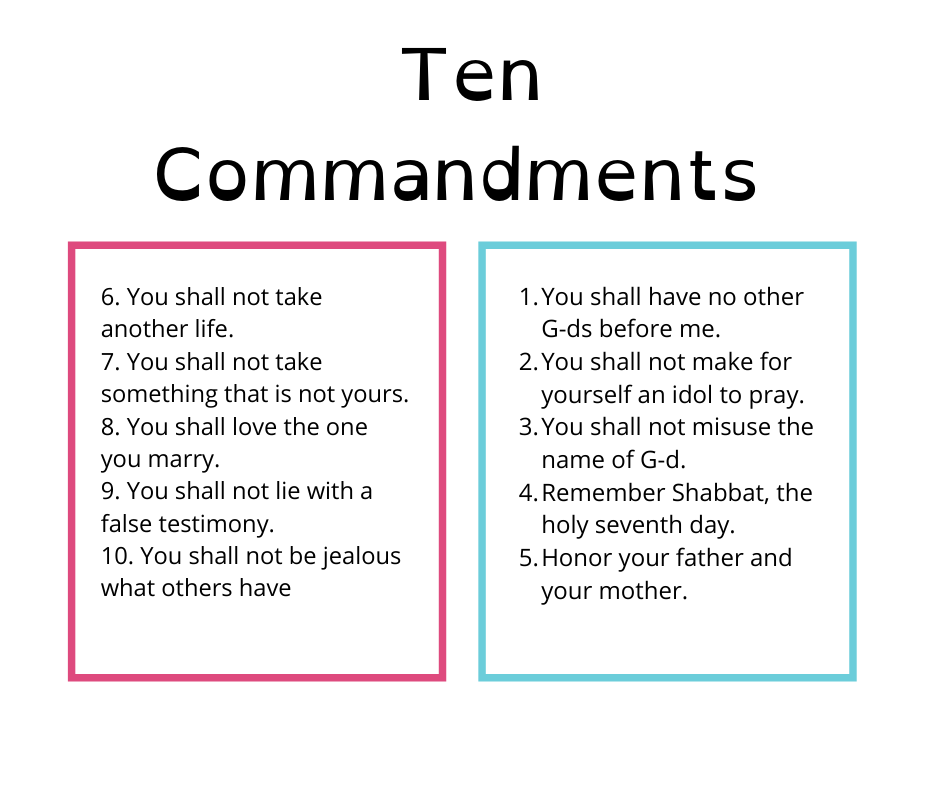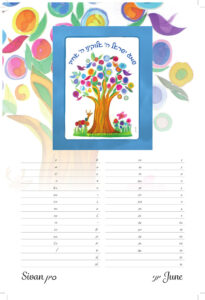In April, the holiday of Passover is celebrated around the table in many homes around the world. Passover 2020 will always be about how technology connected many families to conduct their Seder together online during a pandemic; the Passover story continued to be read and remembered.
When we think of Passover, we think of The Ten Commandments – especially when the famous classic 1956 movie, and the greatest Jewish Story ever told on a grand movie scale, is being aired on television either before or during the holiday.
During one of the many dramatic scenes, Moses presents the tablets that list the Ten Commandments not once, but twice.
The movie covered and narrated the travels of the Israelites from Egypt to Mount Sinai. This is actually the historic timeline that connects to the holiday of Shavuot. The counting of the days in between Passover and Shavuot, the counting of the Omer, marks and remembers when the Israelites reached Mount Sinai.
Let’s begin!
What is Shavuot?
The holiday marks how many days, and how many weeks, it took the Israelites to travel and reach Mount Sinai. It took them 49 days, which equals to seven weeks, to reach their destination. The holiday of Shavuot starts after sundown on the 50th day.
The number seven is a huge symbolic number in Judaism. Observing the Jewish year, you start seeing a pattern.
Hebrew Calendar
Once again, the Hebrew Calendar assists many people when holidays are celebrated on the secular days, listed in the secular calendar. Shavuot falls on the 6th day of the Hebrew Month of Sivan. This day and month will repeat year after year, it’s fixed. It is the secular month and day that changes and provides when holidays are observed in the Common Era.
Calendar Tips: There are 12 Hebrew Calendar Months. Passover is celebrated in the first month, Nisan. Shavuot is in the third month, Sivan. This often confuses many, as Rosh Hashanah is the Jewish New Year. This holiday starts on the first day, after sundown, in the month of Tishri, the seventh month. Along with Yom Kippur, Sukkot, and Simchat Torah. The four holidays are called the High Holiday Cycle.
Photos: Courtesy of Amy Rosen Art
How is Shavuot Celebrated?
Learning about the year-round Jewish holidays is very common. Shavuot is celebrated once again in a communal setting around the kitchen table where all the magic happens and traditional recipes are being prepared. The widely observed custom is to consume dairy on this holiday.
Why Dairy?
Dairy connected foods are what nourished the Israelites during those first 49 days they traveled before reaching Mount Sinai. The life lessons began with portions of food for each day with specific instructions.
What are the symbolic foods we enjoy on Shavuot?
Two classic dishes Jewish people eat on Shavuot are Blintzes and Cheesecake.
Blintzes are very well-known crêpe-like pancakes filled with cheese. A Shavuot favorite in many Jewish households. Did you know that when two blintzes are rolled, filled, and placed next to each other on a plate, they symbolically represent the Torah scroll?
It is essential to remember that the Ten Commandments were displayed on two tablets, each showcasing five. Out of these Ten Commandments the Manual to Life for Jewish people came into being. Turning the first Ten Commandments into 613.
Cheesecake is the top contender to make and bake for the celebration of Shavuot. Although it is more of a dessert, there are no complaints by those enjoying a freshly baked cheesecake as soon as it is ready, no matter what time of day.
My personal favorites have always been the Blintzes and once I learned how to cook them, I was smitten.
Photo: Courtesy of Rabbi Andrea Frank

Photo: Courtesy of Veena Azmanov – Classic Mango Cheesecake
Harvest Time – Did you know?
Did you know that the harvest calendar is deeply connected to the Jewish teachings and the celebration of many holidays? Which of course connects to the many traditional foods we enjoy each holiday.
Shavuot, for example, is being celebrated during the season wheat is harvested in. The holiday is also known as the “Feast of Weeks”, referring to the weeks during which wheat is harvested.
We can also find barley, beets, potatoes, rye, mixed greens, and spinach on the harvest calendar. This is also the time in which many home gardeners plant many of the vegetables that will be ripe during summer and fall.
The Book of Ruth
The Book of Ruth is a well-known story that took place during the barley harvest in Israel. The focus lies on Ruth’s commitment to becoming Jewish. The story is loosely based on receiving the Torah at Mount Sinai.
However, from the Hebrew Scriptures, the Book of Ruth is widely known for those who choose to convert to Judaism. Ruth shows us self-sufficiency, loyalty, and courage. She was in the process of being trained and groomed as a princess to the pagan G-ds. But, it was Judaism with its deep roots she felt most connected to in her heart. Judaism is about moral principles and the belief in the one and only G-d. Which brings us right back to the first Ten Commandments.
Why did G-d give the Ten Commandments?
They are instructions with valuable lessons on how to be a good human being in front of G-d and others.
The Israelites were now free but had no idea on how to live independently. The only home they ever knew was when they lived in Egypt, where Abraham led them to live for most of their lives. The generations that followed only knew one way of living. Then the Egyptian King Ramses II took over the throne as the new Pharaoh, life changed dramatically and the Israelites lost the freedom they have always known. From all the sons of the Israelites, it was Moses who lived to be chosen by G-d to “draw out” and lead the people out of Egypt following G-d’s guidance and teachings.
Why is this time in history so important?
The Israelites received the very first set of the Ten Commandments. One set of five was written on the right tablet, the second five were written on the left. The reason for this order is that Hebrew is being written from right to left.
G-d made a covenant, a promise for all those that accept Torah from the very beginning. It’s a set of very specific guidelines, easy to follow. The expectations are high and therefore referred to as Commandments.

Rabbi Andrea is The Jewish Wedding Rabbi! Based in New York, she primarily serving the Tri-State area. Besides local weddings, she also officiates destination weddings in the United States and all around the world.
As a Rabbi, she officiates and marries couples of all Jewish backgrounds, as well as interfaith couples, creating a memorable Jewish wedding ceremony; connecting the beautiful customs and traditions, the Jewish faith has to offer. What many people do not realize is that a Rabbi is as a clergy person who has the authority to marry all couples signing a state connected marriage license in a civil, non-denominational, wedding ceremony.
Rabbi Andrea is affiliated with the Chavurah L’Dor V’Dor Congregation and with many wedding industry connected professionals. For over 10 years she is also been a member of the ABC Association of Bridal Consultants.
Beside weddings, Rabbi Andrea’s services include Bar and Bat Mitzvah preparations and ceremonies, as well as baby namings. You can find more information on her website.









